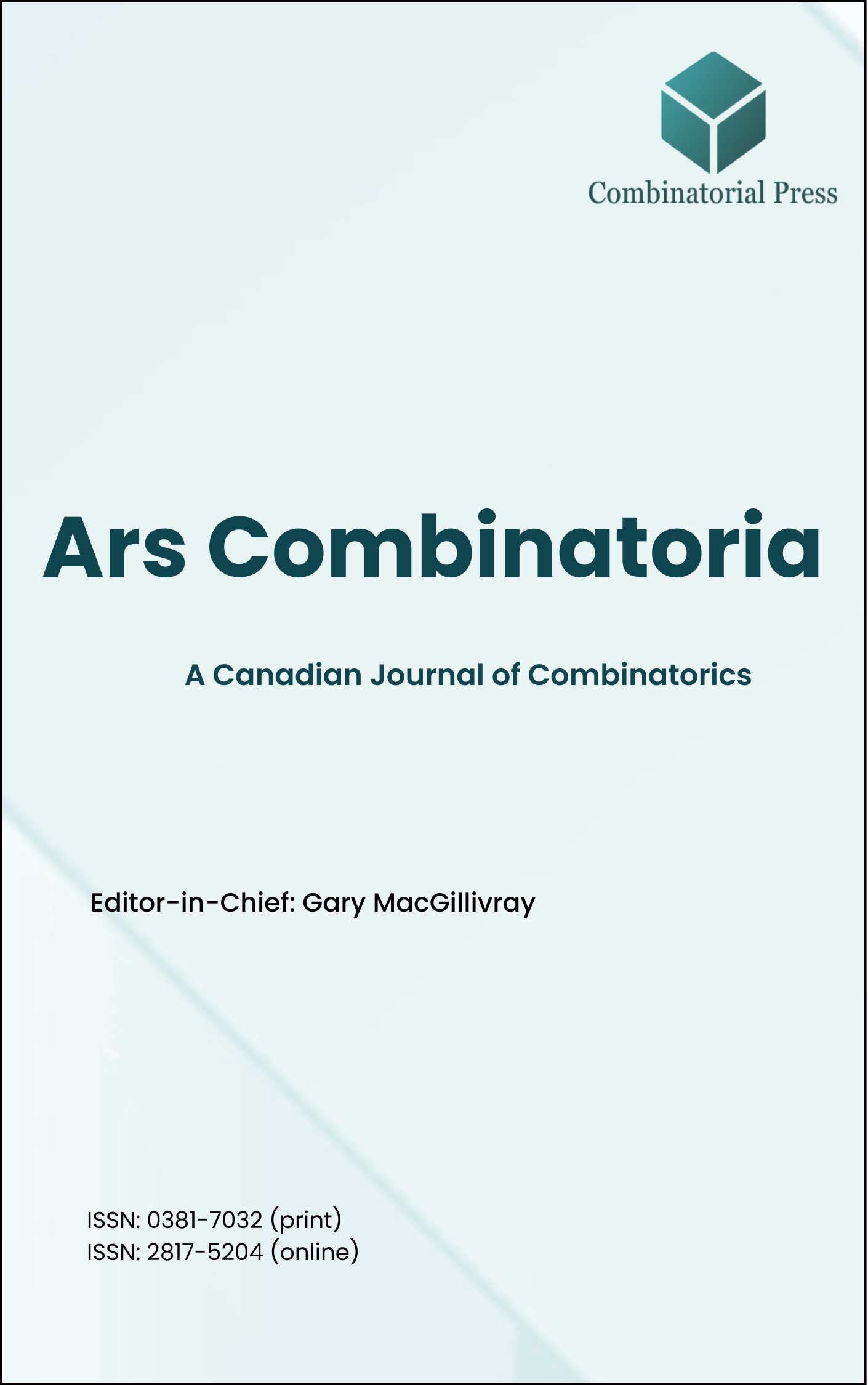
Ars Combinatoria
ISSN 0381-7032 (print), 2817-5204 (online)
Ars Combinatoria is the oldest Canadian Journal of Combinatorics, established in 1976. The journal is dedicated to advancing the field of combinatorial mathematics through the publication of high-quality research papers. From 2024 onward, it publishes four volumes per year in March, June, September and December. Ars Combinatoria has gained recognition and visibility in the academic community and is indexed in renowned databases such as MathSciNet, Zentralblatt, and Scopus. The Scope of the journal includes Graph theory, Design theory, Extremal combinatorics, Enumeration, Algebraic combinatorics, Combinatorial optimization, Ramsey theory, Automorphism groups, Coding theory, Finite geometries, Chemical graph theory but not limited.
Information Menu
- Research article
- Full Text
- Ars Combinatoria
- Volume 036
- Pages: 33-46
- Published: 31/12/1993
The binary matroids with no three- and four-wheel minors were characterized by Brylawski and Oxley, respectively. The importance of these results is that, in a version of Seymour’s Splitter Theorem, Coullard showed that the three- and four-wheel matroids are the basic building blocks of the class of binary matroids. This paper determines the structure of a class of binary matroids which almost have no four-wheel minor. This class consists of matroids \(M\) having a four-wheel minor and an element \(e\) such that both the deletion and contraction of \(e\) from \(M\) have no four-wheel minor.
- Research article
- Full Text
- Ars Combinatoria
- Volume 036
- Pages: 27-31
- Published: 31/12/1993
- Research article
- Full Text
- Ars Combinatoria
- Volume 036
- Pages: 7-26
- Published: 31/12/1993
A pairwise balanced design (PBD) of index \(I\) is a pair \((V,{A})\) where \(V\) is a finite set of points and \(A\) is a set of subsets (called blocks) of \(V\), each of cardinality at least two, such that every pair of distinct points of \(V\) is contained in exactly one block of \(A\). We may further restrict this definition to allow precisely one block of a given size, and in this case the design is called a PBD \((\{K, k^*\},v)\) where \(k\) is the unique block size, \(K\) is the set of other allowable block sizes, and \(v\) is the number of points in the design.
It is shown here that a PBD \((\{5, 9^*\},v)\) exists for all \(v \equiv 9\) or 17 mod 20, \(v \geq 37\), with the possible exception of \(49\), and that a PBD \((\{5, 13^*\},v)\) exists for all \(v \equiv 13 \mod 20\), \(v \geq 53\).
- Research article
- Full Text
- Ars Combinatoria
- Volume 036
- Pages: 3-6
- Published: 31/12/1993
A partition \(\mathcal{D} = \{V_1, \ldots, V_m\}\) of the vertex set \(V(G)\) of a graph \(G\) is said to be a star decomposition if each \(V_i\) (\(1 \leq i \leq m\)) induces a star of order at least two.
In this note, we prove that a connected graph \(G\) has a star decomposition if and only if \(G\) has a block which is not a complete graph of odd order.
- Research article
- Full Text
- Ars Combinatoria
- Volume 036
- Pages: 215-219
- Published: 31/12/1993
This note recapitulates the definition of a ‘double Youden rectangle’, which is a particular kind of balanced Graeco-Latin design obtainable by superimposing a second set of treatments on a Youden square, and reports the discovery of examples that are of size \(8 \times 1\). The method by which the examples were obtained seems likely to be fruitful for the construction of double Youden rectangles of larger sizes.
- Research article
- Full Text
- Ars Combinatoria
- Volume 036
- Pages: 309-314
- Published: 31/12/1993
It has been shown that there exists a resolvable spouse-avoiding mixed-doubles round robin tournament for any positive integer \(v \neq 2, 3, 6\) with \(27\) possible exceptions. We show that such designs exist for \(19\) of these values and the only values for which the existence is undecided are: \(10, 14, 46, 54, 58, 62, 66\), and \(70\).
- Research article
- Full Text
- Ars Combinatoria
- Volume 036
- Pages: 341-350
- Published: 31/12/1993
A graph \(G\) is homogeneously traceable if for each vertex \(v\) of \(G\) there exists a hamiltonian path in \(G\) with initial vertex \(v\). A graph is called claw-free if it has no induced \(K_3\) as a subgraph.
In this paper, we prove that if \(G\) is a \(k\)-connected (\(k > 1\)) claw-free graph of order \(n\) such that the sum of degrees of any \(k+2\) independent vertices is at least \(n-k\), then \(G\) is homogeneously traceable. For \(k=2\), the bound \(n-k\) is best possible.
As a corollary we obtain that if \(G\) is a \(2\)-connected claw-free graph of order \(n\) such that \(NC(G) \geq (n-3)/2\), where \(NC(G) = \min\{|N(u) \cup N(v)|: uv \notin E(G)\}\), then \(G\) is homogeneously traceable. Moreover, the bound \((n-3)/2\) is best possible.
- Research article
- Full Text
- Ars Combinatoria
- Volume 036
- Pages: 335-340
- Published: 31/12/1993
In this note, we consider the problem of constructing magic rectangles of size \(m\) by \(n\), where \(m\) and \(n\) are both multiples of two. What seems to be a new and relatively simple method for constructing many such rectangles is presented.
- Research article
- Full Text
- Ars Combinatoria
- Volume 036
- Pages: 327-334
- Published: 31/12/1993
In [Discrete Math.75(1989)69-99], Bondy conjectured that if \(G\) is a 2-edge-connected simple graph with \(n\) vertices, then \(G\) admits a double cycle cover with at most \(n – 1\) cycles. In this note, we prove this conjecture for graphs without subdivision of \(K_4\) and characterize all the extremal graphs.
- Research article
- Full Text
- Ars Combinatoria
- Volume 036
- Pages: 315-326
- Published: 31/12/1993
In this paper, partial answers to some open problems on harmonious labelings of graphs listed in \([2]\) are given.





